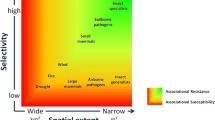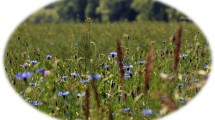Abstract
Extensive grazing applied in the form of low instantaneous pressure over a long period is a widespread management practice in protected areas. However this kind of stocking method does not always achieve the expected results, in particular because it fails to limit colonization by woody plants.This is the case in the relict xero-halophytic grasslands of the northern Mediterranean coastal region, subjected to widespread colonization by the shrub Phillyrea angustifolia despite the presence of extensive grazing. In this study, we investigated, for an equal annual stocking rate, the respective impact of high stocking density applied over a short period (mob grazing) and low stocking density applied over a long period on both P. angustifolia and herbaceous cover, using an in situ experimental design run for 7 years. Only mob grazing was effective both in controlling the establishment and increasing the mortality of P. angustifolia individuals. We did not find any difference after the 7 years of experimentation between the two stocking methods with regard to the herbaceous community parameters tested: species richness, diversity, evenness, contribution of annual characteristic species. By contrast, the exclusion of domestic grazing led to a strong reduction of these values.The use of mob grazing may be well suited for meeting conservation goals such as maintaining open habitats in these grasslands.




Similar content being viewed by others
References
Adams SN (1986) Sheep performance and tree growth on a grazed Sitka spruce plantation. Scott For 40(4):259–263
Allen RB, Wilson JB, Mason CR (1995) Vegetation change following exclusion of grazing animals in depleted grasslands, Central Otago, New Zealand. J Veg Sci 6(5):615–626
Allen VG, Batello EJ, Berreta EJ, Hodgson J, Kothmann M, Li x, McIvor J, Milne J, Morris C, Peeters A, Sanderson M (2011) An international terminology for grazing lands and grazing animals. Grass Forage Sci 66:2–28
Ash AJ, Strafford Smith DM (1996) Evaluating stocking rate impacts in rangelands: Animals don’t practice what we preach. Rangel J 18:216–243
Bakker JP (1989) Nature management by grazing and cutting: On the ecological significance of grazing and cutting regimes applied to restore former species-rich grassland communities in the Netherlands. Springer, Dordrecht, Geobotany 14
Bensettiti F, Boulet V, Chavaudret-Laborie C, Deniaud J (2005) Cahiers d’habitats Natura 2000. Connaissance et gestion des habitats et des espèces d’intérêt communautaire. Tome 4 Habitats agro-pastoraux. MEDD/MAA PAR/MHN. La documentation Française 2:227–229
Briske DD, Derner JD, Brown JR, Fuhlendorf SD, Teague WR, Havstad KM, Gillen RL, Ash AJ, Willms WD (2008) Rotational grazing on rangelands: Reconciliation and perception and experimental evidence. Rangel Ecol Manage 61:3–17
Bullock JM, Silvertown J, Suttonn M (1995) Gap colonization as a source of grassland community change: Effects of gap size and grazing on the rate and mode of colonization by different species. Oikos 72:273–282
Danell K, Bergstrom R, Duncan P, Pastor J (2006) Large herbivore ecology, ecosystem dynamics and conservation. Cambridge University Press, Cambridge
Del Pozo A, Ovalle C, Casado MA, Acosta B, de Miguel JM (2006) Effects of grazing intensity in grasslands of the Espinal of central Chile. J Veg Sci 17(6):791–798
Damgaar Ch, Merlin A, Mesléard F, Bonis A (2011) The demography of space occupancy: measuring plant colonisation and survival probabilities using repeated pin-point measurements. Methods Ecol Evol 2:110–115
Dumont B, Farrugia A, Garel JP, Bachelard P, Boitier E, Frain M (2009) How does grazing intensity influences the diversity of plants and insects in a species-rich upland grassland on basalt soils. Grass Forage Sci 64:92–105
Dumont B, Rossignol N, Loucougaray G, Carrère P, Chadoeuf J, Fleurance G, Bonis A, Farruggia A, Gaucherand S, Ginane C, Louault F, Marion B, Mesléard F, Yavercovski Y (2012) When does grazing generate stable vegetation patterns in temperate pastures? Agric Ecosyt Environ 153:50–56
European Union Habitats Directive (1992) European Union, Brussels. http://ec.europa.eu/environment/nature/legislation/habitatsdirective/indexen.htm
Firincioglu HK, Seefeldt SS, Sahin B (2007) The effects of long-term grazing exclosures on range plants in the central Anatolian region of Turkey. Environ Manage 39(3):326–337
Fuhlendorf SD, Harrel WC, Engle DM, Hamilton RG, Davis CA, Leslie D (2006) Should heterogeneity be the basis for conservation? Grassland bird response to fire and grazing. Ecol Appl 16:1706–1716
Fynn RWS, O’Connor TG (2000) Effect of stocking rate and rainfall on rangeland dynamics and cattle performance in a semi-arid savanna, South Africa. J Appl Ecol 37:491–507
Golodets C, Kigel J, Sternberg M (2010) Recovery of plant species composition and ecosystem function after cessation of grazing in Mediterranean grasslands. Plant Soil 329(1–2):365–378
Gordon I, Duncan P (1988) Pastures new for conservation. New Sci 117:54–59
Hart RH, Ashby MM (1998) Grazing intensities, vegetation, and heifer gains: 55 years on short grass. J Range Mange 51:393–398
Heurteaux P (1970) Rapports des eaux souterraines avec les sols halomorphes et la végétation en Camargue. La Terre et la Vie 24:467–510
Hickman KR, Harneett DC, Cochran RC, Owensby CE (2004) Grazing management effects on plant species diversity in tall grass prairie. J Range Manage 57:58–65
Hobbs RJ, Huenneke LF (1992) Disturbance, diversity and invasion: implications for conservation. Conserv Biol 6(3):324–333
Holechek JL, Gomes H, Molinar F, Galt D, Valdez R (2000) Short-Duration Grazing: The facts in 1999. Rangelands 22(1):18–22
Jaunatre R, Buisson E, Muller I, Morlon H, Mesléard F, Dutoit T (2013) New synthetic indicators to assess community resilience and restoration success. Ecol Indic 29:468–477
Jeltsch F, Milton SJ, Dean WRJ, Van Rooyen N (1997) Analyzing shrub encroachment in the Southern Kalahari: a grid-based modeling approach. J Appl Ecol 34:1497–1508
Marone M, Lill A (1985) The influence of livestock grazing and weed invasion on habitat use by birds in grassy woodland remnants. Biol Conserv 124:439–450
Metzger KL, Coughenour MB, Reich RM, Boone RB (2005) Effects of seasonal grazing on plant species diversity and vegetation structure in a semi-arid ecosystem. JArid Environ 61(1):147–160
Mesléard F, Grillas P, Lepart J (1991) Plant community succession in a coastal wetland after abandonment of cultivation: The example of the Rhône delta. Vegetatio 94:35–45
Mesléard F, Mauchamp A, Pineau O, Dutoit T (2011) Rabbits are more effective than cattle for limiting shrub colonization in Mediterranean xero-halophytic meadows. Ecosciences 18(1):37–41
Mesléard F, Yavercovski N, Dutoit T (2015) Photoperiod buffer responses to salt and temperature during germination of to coastal salt-marsh colonizers Juncus acustus and Juncus maritimus. Plant Biosyst. doi:10180/1126.3504.2015.1007898
Milchunas D, Sala OE, Lauenroth WK (1988) A generalized model of the effects of grazing by large herbivores on grasslands community structure. Am Nat 132(1):87–106
Milchunas DG, Lauenroth WK (1993) Quantitative effects of grazing on vegetation and soils over a global range of environments. Ecol Monogr 67:327–336
MNHN (2015) [Muséum National d’Histoire Naturelle (2003-2015) Inventaire National du Patrimoine Naturel]. http://inpn.mnhn.fr
Molinier R, Tallon G (1968) Etudes botaniques en Camargue. II vers la forêt en Camargue. La Terre et la Vie 19:3–197
Noss RF (1990) Indicators for monitoring biodiversity: A hierarchical approach. Conserv Biol 4:355–364
Noy-Meir I, Gutman M, Kaplan Y (1989) Responses of Mediterranean grasslands plants to grazing and protection. J Ecology 77(1):290–310
Olff H, Ritchie ME (1998) Effects of herbivores on grasslands plant diversity. Trends Ecol Evol 13(7):261–265
Osem Y, Perevolotsky A, Kigel J (2002) Grazing effect on diversity of annual plant communities in a semi‑arid rangeland: interactions with small-scale spatial and temporal variation in primary productivity. J Ecol 90:936–946
Pannel JR, Ojeda F (2000) Patterns of flowering and sex-ratio variation in the Mediterranean shrub Phillyrea angustifolia (Oleaceae): Implications for the maintenance of males with hermaphrodites. Ecol Lett 3:495–502
Peco B, de Pablos I, Traba J, Levassor C (2005) The effect of grazing abandonment on species composition and functional traits: the case of dehesa grasslands. Basic Appl Ecol 6(2):175–183
Perevolotsky A, Seligman NG (1998) Degradation of Mediterranean rangeland ecosystems by grazing: inversion of a paradigm. BioScience 48:1007–1017
Pickett STA, White PS (1985) The ecology of natural disturbances and patch dynamics. Academic, New York, NY
Pielou EC (1975) Ecological diversity. Wiley, New York, NY
Ralphs MH, Kothmann MM, Taylor CA (1990) Vegetation response to increased stocking rates in short-duration grazing. J Range Manage 43:104–108
Rambo JL, Faeth SH (2001) Effect of vertebrate grazing on plant and insect community. Conserv Biol 13(5):1047–1054
Rosenthal G, Schrautzer J, Carsten E (2012) Low-intensity grazing with domestic herbivores: a tool for maintaining and restoring plant diversity in temperate Europe. Tuexenia 32:167–205
Rutherford MC, Powrie LW (2011) Can heavy grazing on communal land elevate plant species richness levels in the Grass land Biome of South Africa. Plant Ecol 212:1407–1418
Rykiel EJ (1985) Toward a definition of ecological disturbance. Aust J Ecol 10:361–365
Salihi DO, Norton BE (1987) Survival of perennial grass seedlings under intensive grazing in semi-arid rangelands. J Appl Ecol 24:145–151
Saumitou-Laprade P, Vernet P, Vassiliasi C, Hoareau Y, DeMagny G, Dommee B, Lepart J (2010) A self-incompatibility systems explains high male frequencies in an androdiocious plant. Science 327:1648–1650
Savory A (1983) The savory grazing method or holistic resource management. Rangelands 5:155–159
Savory A (1988) Holistic resource management. Island Press, Covelo, CA
S R M (1998) Glossary of terms used in range management, 4th edn. Society for Range Management. https://globalrangelands.org/glossary?
Suding KN, Goldberg D (2001) Do disturbances alter competitive hierarchies? Mechanisms of change following gap creation. Ecology 82(2):2133–2149
Todd SW, Hoffman MT (1999) A fence-line contrast reveal effects of heavy grazing on plant diversity and community composition in Namaqualand, South Africa. Plant Ecol 142:169–178
Traveset A, Rodríguez-Pérez J, Pías B (2008) Seed trait changes in dispersers’ gut and consequences for germination and seedling growth. Ecology 89:95–106
Van Wieren SE, Bakker JP (1998) Grazing for conservation in the 21st century. In: Wallis DeVries MF, Bakker JP, Van Weiren SE (eds) Grazing and conservation management. conservation biology series 11. Kluwer Academic, Dordrecht, p 349–363
WallisDeVries MF (1998) Large herbivores as key factors for nature conservation. In: Wallis DeVries MF, Bakker JP, Van Weiren SE (eds) Grazing and conservation management. conservation biology series 11. Kluwer Academic, Dordrecht, p 1–20
WallisDeVries MF, Parkinson AE, Dulphy JP, Sayer M, Diana E (2007) Effects of livestock breed and grazing intensity on biodiversity and production in grazing systems. Grass Forage Sci 62:185–197
Acknowledgements
This work was supported by the Fondation Tour du Valat and the Fondation MAVA. We warmly thank the staff of Tour du Valat estate, especially Olivier M. Pineau and volunteers involved in grazing management, for their help.
Author information
Authors and Affiliations
Corresponding author
Ethics declarations
Conflict of interest
The authors declare that they have no competing interests.
Rights and permissions
About this article
Cite this article
Mesléard, F., Yavercovski, N., Lefebvre, G. et al. High Stocking Density Controls Phillyrea Angustifolia in Mediterranean Grasslands. Environmental Management 59, 455–463 (2017). https://doi.org/10.1007/s00267-016-0808-x
Received:
Accepted:
Published:
Issue Date:
DOI: https://doi.org/10.1007/s00267-016-0808-x




